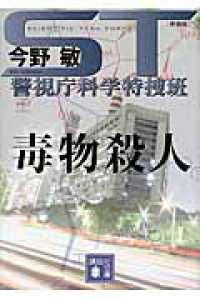- ホーム
- > 洋書
- > ドイツ書
- > Social Sciences, Jurisprudence & Economy
- > Social Sciences
- > social sciences in general
Full Description
Field practice in archaeology varies greatly throughout the world, mainly because archaeological sites survive in very different ways in different counties. Many manuals see this as a problem - to be defeated by the imposition of standardised procedures. In this book we relish the variety of field practice, seeing it rather as the way the best archaeologists have responded creatively to the challenges of terrain, research objectives and the communities within which they work. While insisting on the highest levels of investigation, we celebrate the different designs, concepts, scientific detection methods and recording systems applied - so embracing standards, but not standardisation. The book is organised in four parts:
Part 1 offers a summary of field procedures.
Part 2 reviews the principal methods applied, above and below ground, and how the results are analysed.
Part 3 illustrates the huge variety confronted by field workers with a series of exemplary commercial and academic projects enacted in downland, jungle, desert, permafrost, road schemes and towns. Approaches also differ according to the traditional methodologies that have evolved in particular countries.
In Part 4 we give examples of some the strongest and oldest of those practised on four continents.
Contents
Part 1: Methods.- Chapter 1: Field Method in Archaeology: Overview.- Chapter 2: Natural and Cultural Formation Processes.- Chapter 3: Aerial archaeology.- Chapter 4: Surface Survey: Method and Strategies.- Chapter 5: Non-destructive Subsurface Mapping.- Chapter 6: Excavation methods.- Chapter 7: The Archaeological Study of Buildings.- Chapter 8: Recording Fieldwork.- Chapter 9: Spatial analysis.- Chapter 10: Sequence and Date.- Chapter 11: Ethno-archaeology: approaches to fieldwork.- Chapter 12: Publication.- Part 2: Projects.- Chapter 13: Large scale landscape mapping in Yorkshire, England.- Chapter 14: Seascape Survey on the Inner Ionian archipelago.- Chapter 15: Archaeology in advance of motorway construction in Ireland.- Chapter 16: Digging through permafrost in Siberia.- Chapter 17: A tropical rainforest site in Belize Cynthia Robin.- Chapter 18: Excavating a Rock shelter in north-west Greece Nena Galanidou.- Chapter 19: Excavation and survey at Pinnacle Point, S Africa.- Chapter 20: An upper Paleolithic living floor at Monruz, Switzerland.- Chapter 21: On the beach in Remote Oceania.- Chapter 22: Defining the Neolithic on the German loess.- Chapter 23: Crannóg investigations in Scotland.- Chapter 24: Investigating Tells in Syria.- Chapter 25: Terp excavation in the Netherlands.- Chapter 26: A terramare site on the Po Plain, Italy.- Chapter 27: Hillfort investigations in the Czech Republic.- Chapter 28: Excavating burials in Anglo-Saxon England.- Chapter 29: A Burial mound dissection in Sweden.- Chapter 30: Down a mine at Gavá, Spain.- Chapter 31: Urban archaeology at Five Points New York City.- Chapter 32: After the earthquake in Bam, Iran; archaeological and social investigations.- Chapter 33: Ethnoarchaeology in the field: Learning from potters in Gilund, India.- Part 3: Traditions.- Chapter 34: America.- Chapter 35: Poland.- Chapter 36: Britain.- Chapter 37: Scandinavia.- Chapter 38: France.- Chapter 39: China.- Chapter 40: Japan.- Chapter41: Australia.








